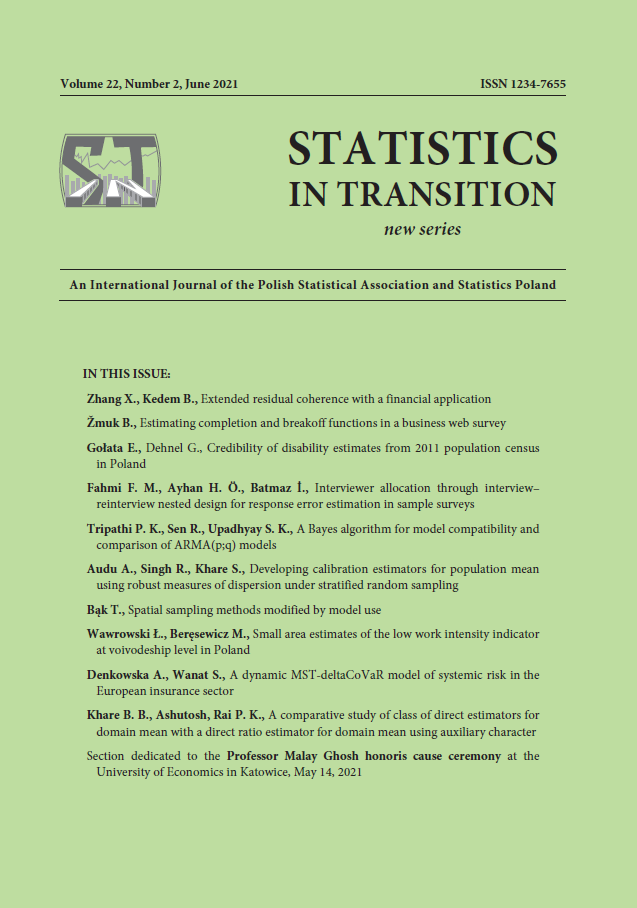ARTICLE
ABSTRACT
Recent years have seen an intensive development in the field of spatial sampling methods, which generally focus on a balanced distribution of the sample in space. Adaptive sampling methods constitute another dynamic direction in the sampling theory. The issue raised in this article involves the combination of these directions. Five of the commonly known spatial sampling methods have been analysed. The experiment was designed to include statistical model in the sampling procedure. As in the case of adaptive methods, it serves to modify drawing probabilities during sampling. The necessary theory of this sampling modification has been developed and presented. An experiment using artificial data was conducted in order to analyse the efficiency of the model modification in comparison with the primary methods.
KEYWORDS
spatial sampling, drawn-by-drawn sampling, kriging, employees distribution
REFERENCES
Bąk, T., (2014). Triangular method of spatial sampling. Statistics in Transition, Vol. 15/2, pp. 9–22.
Bryant, D., Chang, Y., Rodger, C., and Wei, R., (2002). Two-dimensional balanced sampling plans excluding contiguous units. Communications in Statistics - The- ory and Methods, Vol. 31/8, pp. 1441–1455.
Combes, P.-P., Overman, H., (2004). The spatial distribution of economic activities in the European union. Handbook of Regional and Urban Economics, Vol. 4, pp. 2845–2909.
Cressie, N., (1993). Statistics for Spatial Data. Wiley.
Deville, J.-C., Tillé, Y., (2004). Efficient balanced sampling: The cube method. Biometrika, 91(4), pp. 893–912.
Fattorini, L., (2006). Applying the Horvitz-Thompson criterion in complex designs: a computer-intensive perspective for estimating inclusion probabilities. Biometrika, 93, pp. 269–278.
Fattorini, L., Corona, P., Chirici, G., and Pagiarella, C., (2015). Design-based strategies for sampling spatial units from regular grids with applications to forest sur- veys, land use, and land cover estimation. Environmetrics, 26, pp. 216–228.
Gamrot, W., (2014). Estimators for the Horvitz-Thompson statistic based on some posterior distributions. Mathematical Population Studies, 21(1), pp. 12–29.
Glaeser, E., Kerr, W., (2009). Local industrial conditions and entrepreneurship: How much of the spatial distribution can we explain? Journal of Economics & Management Strategy, 18, pp. 623–663.
Grafström, A., (2012). Spatially correlated poisson sampling. Journal of Statistical Planning and Inference, 142, pp. 139–147.
Grafström, A., Lundström, P., and Schelin, L., (2012). Spatially balanced sampling through the pivotal method. Biometrics, 68, pp. 514–520.
Grafström, A., Tillé, Y., (2013). Doubly spatial sampling with spreading and restitution of auxiliary totals. Environmetrics, 24, pp. 120–131.
Hiemstra, P., Pebesma, E., Twenhöfel, C., and Heuvelink, G., (2008). Real-time automatic interpolation of ambient gamma dose rates from the Dutch Radioactivity Monitoring Network. Computers & Geosciences.
Stevens Jr, D., Olsen, A., (2004). Spatially balanced sampling of natural re- sources. Journal of the American Statistical Association, 99, pp. 262–278.
Thompson, M., Wu, C., (2008). Simulation-based randomized systematic PPS sampling under substitution of units. Survey Methodology, 34, pp. 3–10.
Thompson, S., (2006). Adaptive web sampling. Biometrics, Vol. 62, No. 4, pp. 1224–1234.
Thompson, S., Seber, G., (1996). Adaptive Sampling. John Wiley & Sons, Inc.
Wywiał, J., (1996). On space sampling. Statistics in Transition, Vol.7, No. 7, pp. 1185– 1191.
